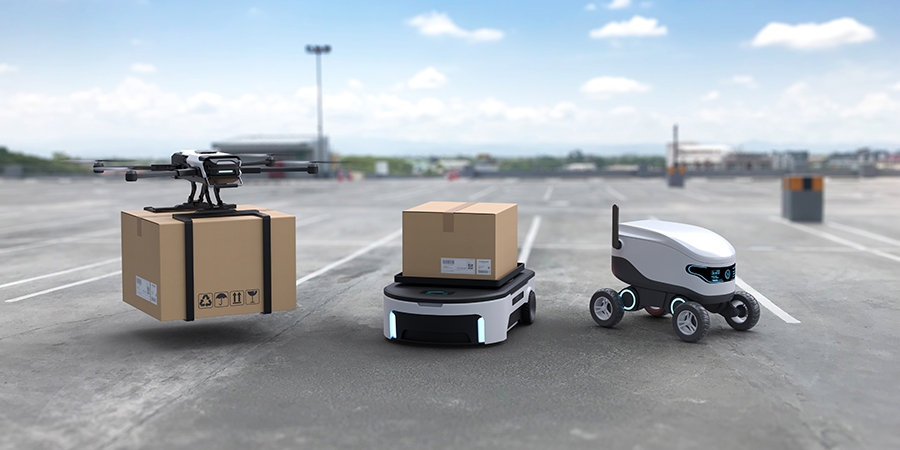Autonomous Mobile Robots
Introduction
The world of robotics is rapidly evolving, and at the forefront of this technological revolution are Autonomous Mobile Robots (AMRs). These intelligent machines, equipped with advanced sensors and artificial intelligence, are changing the way industries operate and impacting our daily lives. In this blog, we will delve into the realm of AMRs, uncovering their versatile applications across various sectors, highlighting the myriad benefits they offer, and catching a glimpse of the exciting future they hold.

Autonomous mobile robots (AMRs) have emerged as one of the most transformative technologies in recent years, revolutionizing various industries and reshaping our daily lives. These robots, equipped with advanced sensors, artificial intelligence (AI), and autonomous navigation capabilities, are changing the way we work, manufacture, and even shop. In this blog, we will explore the fascinating world of AMRs, their applications across different sectors, and the potential implications for the future.
The Rise of AMRs in Industrial Automation
Autonomous Mobile Robots have found a significant home in the industrial landscape. From manufacturing facilities to vast warehouses, AMRs are being employed to enhance efficiency, streamline processes, and reduce operational costs. These robots can handle a wide array of tasks, including material handling, product assembly, quality control, and inventory management.
What sets AMRs apart is their adaptability. They can easily be reprogrammed to accommodate changing production demands and can work seamlessly alongside human counterparts. Navigating through complex environments, avoiding obstacles, and optimizing routes, AMRs are invaluable in optimizing large-scale operations. As a result, industries are experiencing increased productivity, reduced downtime, and improved workplace safety.
- AMRs are transforming industrial operations.
- Applications in manufacturing and warehouses.
- Versatile tasks: material handling, assembly, quality control, and inventory management.
- Adaptability and seamless collaboration with humans.
- Enhanced productivity, reduced downtime, and improved safety.
AMRs in Healthcare and Service Sectors
The healthcare sector has warmly welcomed AMRs to the forefront of patient care and facility management. These robots play a pivotal role in medication delivery, patient monitoring, and even assisting in surgeries. In hospital pharmacies, AMRs ensure the precise dispensing of medications, thereby reducing the risk of human errors. Moreover, they contribute to edit the sterilization and cleanliness of hospital rooms, ultimately curbing the spread of infections.
Beyond healthcare, service-oriented AMRs are enhancing customer experiences across different domains. In the retail sector, these robots guide shoppers to their desired products, manage inventory, and even facilitate checkout processes. Hospitality establishments are also deploying AMRs to deliver room service and items to guests, enhancing overall service efficiency and convenience.
- AMRs in healthcare for patient care and facility management.
- Roles in medication delivery, patient monitoring, and surgery assistance.
- Ensuring accurate medication dispensing and infection control.
- Service-oriented AMRs in retail and hospitality.
- Tasks include guiding shoppers, managing inventory, and delivering room service.
E-commerce and Last-Mile Delivery
E-commerce is one sector that has undergone a remarkable transformation thanks to AMRs. Online retailers and logistics companies are leveraging these robots to automate their order fulfillment processes. Within vast warehouses trends, AMRs pick and transport products to human workers who then complete the packing and shipping stages. This has led to a significant reduction in order processing times, allowing businesses to meet the ever-increasing demand for online shopping efficiently.
Furthermore, AMRs are making their presence felt in the last-mile delivery segment. Leading companies like Amazon are experimenting with delivery robots designed to navigate sidewalks and deliver packages right to customers’ doorsteps. This approach not only accelerates delivery times but also minimizes the environmental impact compared to traditional delivery vehicles.
- Transformation of e-commerce with AMRs.
- Automation of order fulfillment processes in vast warehouses.
- Reduction in order processing times.
- Introduction of last-mile delivery robots by companies like Amazon.
- Faster deliveries and reduced environmental impact.
Conclusion
The future appears incredibly promising for Autonomous Mobile Robots. As technology continues to advance, we can expect to witness an even wider adoption of AMRs in industries and applications we might not have previously envisioned. However, with these technological advancements come ethical considerations and regulatory challenges that must be addressed to ensure the responsible and safe deployment of AMRs.
In the coming years, we can anticipate a world where AMRs become an integral part of our daily lives, offering support in various tasks and enhancing our overall quality of life. The rise of Autonomous Mobile Robots is not just a passing trend; it’s a transformative force poised to reshape industries and society as a whole.

